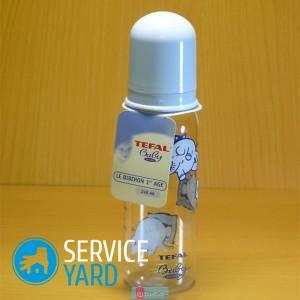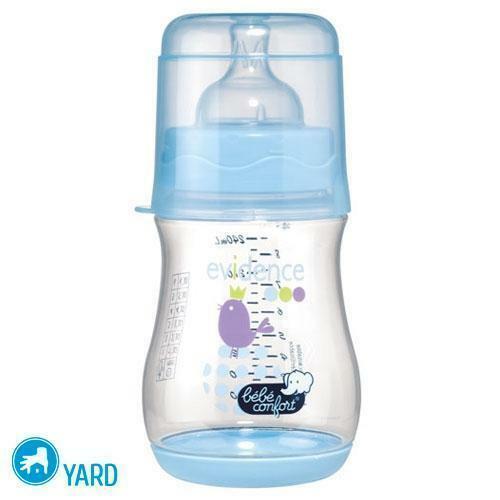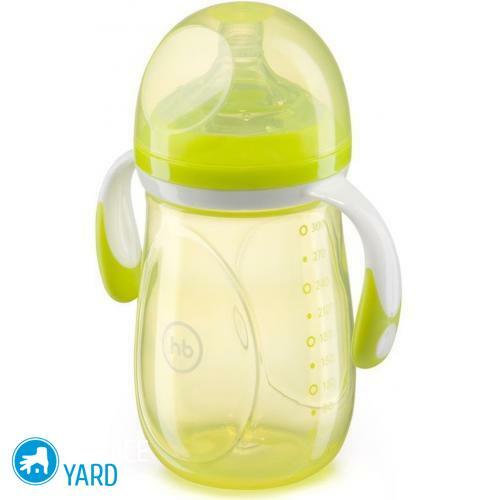
- How to properly wash the feeding bottles?
- Sterilization of bottles
- How to wash baby bottles while traveling?
Who has a small child in his family, he is certainly familiar with the feeding bottles, nipples, diapers, and dummies and probably knows how and how to wash baby bottles and other objects surrounding the baby. Such knowledge is necessary for absolutely all young parents, because incorrect actions concerning cleaning of objects of children's use can not only damage the things themselves, but also lead to a negative reaction of the child's body. The thing is that the newborn baby has not yet fully developed its immune system, and this makes it more susceptible to bacteria that are on improperly treated surfaces.
Important! When purchasing plastic bottles for newborns, make sure that the chemical composition Bisphenol-A is not included in the plastic composition. It is very toxic and can lead to serious disability of the baby. Many countries have already banned the production and sale of children's items with an admixture of this chemical. Unfortunately, while our country is not on this list. Therefore, parents need to be more vigilant when buying children's products.
to the contents ↑How to properly wash the feeding bottles?
To care for the dishes for feeding was ideal, you need to know the detailed instructions how to wash baby bottles. It looks like this:

- Immediately after feeding, rinse the bottle in the sink:
- Even if you do not have time for more thorough washing, just rinse the dish. This will not allow the dried milk and dirt to accumulate on the walls and bottom of the bottle.
- Use hot water to rinse. Thus, rinsing will be more effective.
- To make the washing process more effective, you need to know what to wash the baby bottles best. When buying a feeding bottle, immediately purchase the following products:
- Erschik for washing children's dishes and a special brush for washing the rubber nipple. Some bottles are difficult to clean near the bottom and in the neck area, the brush will help. Brushes for cleaning the nipple have the properties to collect bacteria from their surfaces.
- This product is specially designed for washing baby bottles. It differs from the usual means for washing dishes by a more gentle and mild effect. It is hypoallergenic, non-toxic and, no less importantly, does not leave soapy residue on the container surfaces after rinsing in hot or cold water.
- To eliminate the possibility of ingestion of foreign bacteria and chemicals on children's dishes, it is recommended to wash the wash basin before washing it.
- For best effect, use a stiff sponge, baking soda or other disinfectant of natural origin.
- After processing the sink, fill it with hot water of the highest possible temperature and soap.
- Before cleaning the feeding bottles, they must be completely disassembled. Each part of them - a bottle, a nipple, a ring, a cap, are washed separately.
Important! Separate washing is recommended for the reason that as a rule, a large amount of milk accumulates between the ring and the nipple, which contributes to the rapid growth of bacteria.
- Immerse each part in hot soapy water.
- Use a bottle brush and a nipple brush, which can also be washed and a ring.
- If the instructions for using a feeding bottle say that it can be washed in a dishwasher, then use this method, which will save you a lot of time.
- Place the bottle upside down on the top shelf of the dishwasher, away from the heating elements.
Important! Today, children's goods stores can offer their customers a special basket for washing rings and nipples, which are installed in the dishwasher.
- To get rid of soap residues on the surfaces of the bottle and its elements, after washing, rinse thoroughly under running water with the highest possible temperature.
- Place all parts of the baby bottle on the shelf for drying.
Important! Dry the bottle in a well-ventilated area so that it quickly dry completely. Otherwise, fungus and mold can develop on its surfaces.
- Wash your hands thoroughly with soap before taking a dry baby bottle and offering it to your baby.
Sterilization of bottles
This method is very effective for the destruction of all possible bacteria on the surfaces of children's dishes. If earlier, after each use of the bottle, it was advised to sterilize, but now this process is considered not so necessary.
Important! Recent studies by the medical community have shown that washing bottles for feeding hot soapy water is enough to clean them. The main condition remains the purity of water and its suitability for drinking.
And, nevertheless, you can not do without sterilization in the following cases:
- Before the first use of dishes for a newborn immediately after purchase.
- After each washing of the bottle with water from a well or well.
- After a child's illness.
- After extended use.
Electric and microwave sterilizers
The principle of sterilization in these devices is the treatment of dishes with steam temperature of +100 C. Steam with such a high temperature kills all bacteria and microbes on the surfaces of the bottle. To properly use these devices:
- The electric sterilizer should be filled with a small amount of water. Put the rings, nipples and bottles in some distance from each other inside the ring. Sterilization takes about 10 minutes.
- With a microwave sterilizer, the actions are essentially the same. After placing all items that require sterilization, place the appliance in the microwave oven. Select the microwave mode with full power and turn it on for 4-8 minutes.
Important! The operating time of the microwave oven depends solely on the power of the device itself.
Sterilization in the steamer
The steamer is a fairly common item in the kitchen of the young housewife. With the help of it you can not only cook useful and tasty food, but also if you need to sterilize children's dishes. To do this:
- Pour water into the bottom compartment of the steamer.
- Place the bottles with the neck down.
- Other baby bottle items can be placed on the top of the steamer.
- Switch on the appliance in cooking mode for 5 to 15 minutes.
- Wait until the steam cooker turns off and cools down.

After this, baby dishes can be used for their intended purpose.
Sterilization in the multivariate
It is very easy to sterilize in the multivark:
- Fill 1 liter of water into the main capacity of the multivarker.
- Put all the items of children's dishes that need to be sterilized, on a grill for steaming food.
- Turn on steam mode, setting the time to 7-10 minutes.
Sterilization in the microwave
- For this process, it is better to use special bags or additional containers with a cover in the microwave oven.
- Children's dishes are placed in a container or bag and filled with cold water.
- After 7-8 minutes of operation of the microwave, the baby bottle will be sterilized.
Boiling
Mothers, grandmothers and their predecessors were not familiar in their youth either with microwave ovens or with sterilizers. And yet, they are no worse than modern moms taking care of their children. Today, a large number of young parents use the old and proven method of sterilization - boiling.
This is very simple:
- Pour a large pot of water and bring it to a boil.
- Put all the parts of the feeding bottle into the boiling liquid.
- Cover the pan with a lid and boil the items - at least 3 minutes.
Important! This method of sterilization is most suitable for bottles of glass. If the plastic bottle does not contain the above-mentioned harmful component - bisphenol-A, it can also be processed by this method.
Cold water sterilization
This process can be carried out using cold water and a special preparation that has antiseptic properties. In this case, to wash baby bottles to get the effect of sterilization, it is necessary such means as Milton or Bebe Comfort. They are sold in pharmacies. According to instructions?
- They are dissolved in cold water and placed in a solution of children's dishes.
- After half an hour, remove the dishes from the solution and rinse thoroughly with boiled water.
Important! This method protects children's dishes well from microbes without damaging it.
to the contents ↑How to wash baby bottles while traveling?
Kids never allow parents to relax. Therefore, when traveling, you need to be prepared for various minor troubles. To solve the problem, than to wash baby bottles during the trip, always carry a small container with soap and a brush.
Important! It is best to put the brush in a sealed zip bag. So you will save it from unnecessary external bacteria.
How to act:
- If you have the means for washing a bottle and a brush, you can wash the children's dishes in any sink.
Important! Remember the rules of how to wash bottles for newborns. Strictly follow them, even if you are far from home.
- During travel you will need a disposable sterile liner in a bottle. With their help, you can manage throughout the trip one bottle and wash it only once a day, for example, in the evening.
Important! Inserts must be changed after each meal of the baby.
- Find out if there are places in your overnight stay and microwave ovens. If they are available, then take a sterilizer for portable microwave type with you on a trip.
- If the microwave is not available for you or for other reasons you can not use the sterilizer, then you can get by using an ordinary kettle with water. Steep with boiling water all the washed parts of the bottle for the newborn.
- After washing, spread the bottle and its elements on a clean towel for drying.
Important! Use this towel only for these purposes .
Taking care of your baby's health, be sure to worry about the cleanliness of the objects that surround it. Especially it concerns the children's dishes, which the child uses in the first months of life. If you correctly approach this question, washing baby bottles will not take you much time and effort, and the baby will be protected from unnecessary microorganisms.



